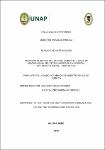| dc.contributor.advisor | Chuquipiondo Carranza, Carmen Melida | |
| dc.contributor.advisor | Rojas Torres, Cinthya Irene | |
| dc.contributor.author | Chung Rengifo, Augusto | |
| dc.contributor.author | Rengifo Jiménez, Jessica Lizbeth | |
| dc.date.accessioned | 2024-07-04T17:17:18Z | |
| dc.date.available | 2024-07-04T17:17:18Z | |
| dc.date.issued | 2023 | |
| dc.identifier.other | 616.15 Ch94 2023 | |
| dc.identifier.uri | https://hdl.handle.net/20.500.12737/10256 | |
| dc.description.abstract | The study of the moment in which the clamping of the umbilical cord is carried out and its effect regarding the value of hemoglobin in neonates by eutocic delivery who were born in the hospital III EsSalud Iquitos (a city located in the Peruvian Amazon located at an altitude of 106 m.s.n.m.) during the period from January to December 2022, for this, 689 records of newborns were evaluated with the purpose of finding the impact of the moment in which the umbilical cord clamping is performed on the hemoglobin level. The clamping process was carried out in an average time of 82 seconds, with a minimum time of 10 seconds and a maximum time of 140 seconds. Regarding the clamping time, the newborns were classified into two groups: Early Clamping (during the first 60 seconds) and Late Clamping (after 60 seconds). 39.62% presented a type of early clamping; while 60.38% presented a type of late clamping. Highly significant differences were found, the most frequently used type of clamping was late, with a time that varied between 85 and 105 seconds. 17.71% presented anemia; while 76.63% presented normal hemoglobin; and 5.66% presented polycythemia. The majority of newborns presented normal type hemoglobin, with a level that varied between 17.1 gr/dl and 17.5 gr/dl. Late clamping is more related to the type of normal hemoglobin. On the other hand, when analyzing a possible association between clamping time and other biomedical characteristics (weight, gestational age by Capurro, sex); No associations were found, so these variables are independent, in relation to the clamping time. The hemoglobin level in both sexes has a similar association with clamping time. At the end of the study, considering the results obtained, late clamping is recommended. | en_US |
| dc.description.abstract | Se realizó el estudio del momento en que se efectúa el clampaje del cordón umbilical y su efecto respecto al valor de hemoglobina en los neonatos por parto eutócico que nacieron en el hospital III EsSalud Iquitos (ciudad ubicada en la Amazonía Peruana situada a una altitud de 106 m.s.n.m.) durante el periodo de enero a diciembre de 2022, para ello se evaluó 689 registros de recién nacidos con el propósito de encontrar el impacto del momento en el cual se realiza el clampaje del cordón umbilical sobre el nivel de hemoglobina. El proceso de clampaje se realizó en un tiempo promedio de 82 segundos, con un tiempo mínimo de 10 segundos y un tiempo máximo de 140 segundos. En relación con el tiempo de clampaje, los recién nacidos fueron clasificados en dos grupos: Clampaje Precoz (durante los primeros 60 segundos) y Clampaje Tardío (después de los 60 segundos). El 39,62% presentaron un tipo de clampaje precoz; mientras que el 60,38% presentó un tipo de clampaje tardío. Se encontró diferencias altamente significativas, el tipo de clampaje utilizado con mayor frecuencia fue el tardío, con un tiempo que varía entre los 85 y 105 segundos. El 17,71% presentaron anemia; mientras que el 76,63% presentaron hemoglobina normal; y el 5,66% presentaron policitemia. La mayoría de recién nacidos, presentaron una hemoglobina de tipo normal, con un nivel que varía entre los 17,1 gr/dl y 17,5 gr/dl. El clampaje tardío, está más relacionada con el tipo de hemoglobina normal. Por otro lado, al analizar una posible asociación, entre de tiempo de clampaje y otras características biomédicas (peso, edad gestacional por Capurro, sexo); no se encontraron asociaciones por lo que dichas variables son independientes, en relación con el tiempo de clampaje. El nivel de hemoglobina en ambos sexos tiene similar asociación con el tiempo de clampaje. Al finalizar el estudio, considerando los resultados obtenidos se recomienda realizar el clampaje tardío. | es_PE |
| dc.format | application/pdf | es_PE |
| dc.language.iso | spa | es_PE |
| dc.publisher | Universidad Nacional de la Amazonía Peruana | es_PE |
| dc.rights | info:eu-repo/semantics/openAccess | * |
| dc.rights.uri | https://creativecommons.org/licenses/by/4.0/ | * |
| dc.subject | Hemoglobinas | es_PE |
| dc.subject | Clampeo del cordón umbilical | es_PE |
| dc.subject | Recién nacido | es_PE |
| dc.subject | Instituciones de salud | es_PE |
| dc.title | Tiempo de clampaje del cordón umbilical y nivel de hemoglobina del recién nacido en un hospital del seguro social - Iquitos 2022 | es_PE |
| dc.type | info:eu-repo/semantics/masterThesis | es_PE |
| thesis.degree.discipline | Maestría en Salud Pública | es_PE |
| thesis.degree.grantor | Universidad Nacional de la Amazonía Peruana. Escuela de Postgrado | es_PE |
| thesis.degree.name | Maestro(a) en Salud Pública | es_PE |
| dc.subject.ocde | https://purl.org/pe-repo/ocde/ford#3.03.03 | es_PE |
| renati.author.dni | 46969203 | |
| renati.author.dni | 44344475 | |
| renati.advisor.orcid | https://orcid.org/0000-0001-5981-5499 | |
| renati.advisor.orcid | https://orcid.org/0009-0003-2824-009X | |
| renati.advisor.dni | 05344802 | |
| renati.advisor.dni | 41638724 | |
| renati.type | https://purl.org/pe-repo/renati/type#trabajoDeInvestigacion | es_PE |
| renati.discipline | 021047 | es_PE |
| renati.level | https://purl.org/pe-repo/renati/level#maestro | es_PE |
| renati.juror | Chuecas Velásquez, Eduardo Tómas | |
| renati.juror | Ruíz Tello, Sergio | |
| renati.juror | Baldeón Ríos, Jorge Luis | |
| dc.publisher.country | PE | es_PE |





